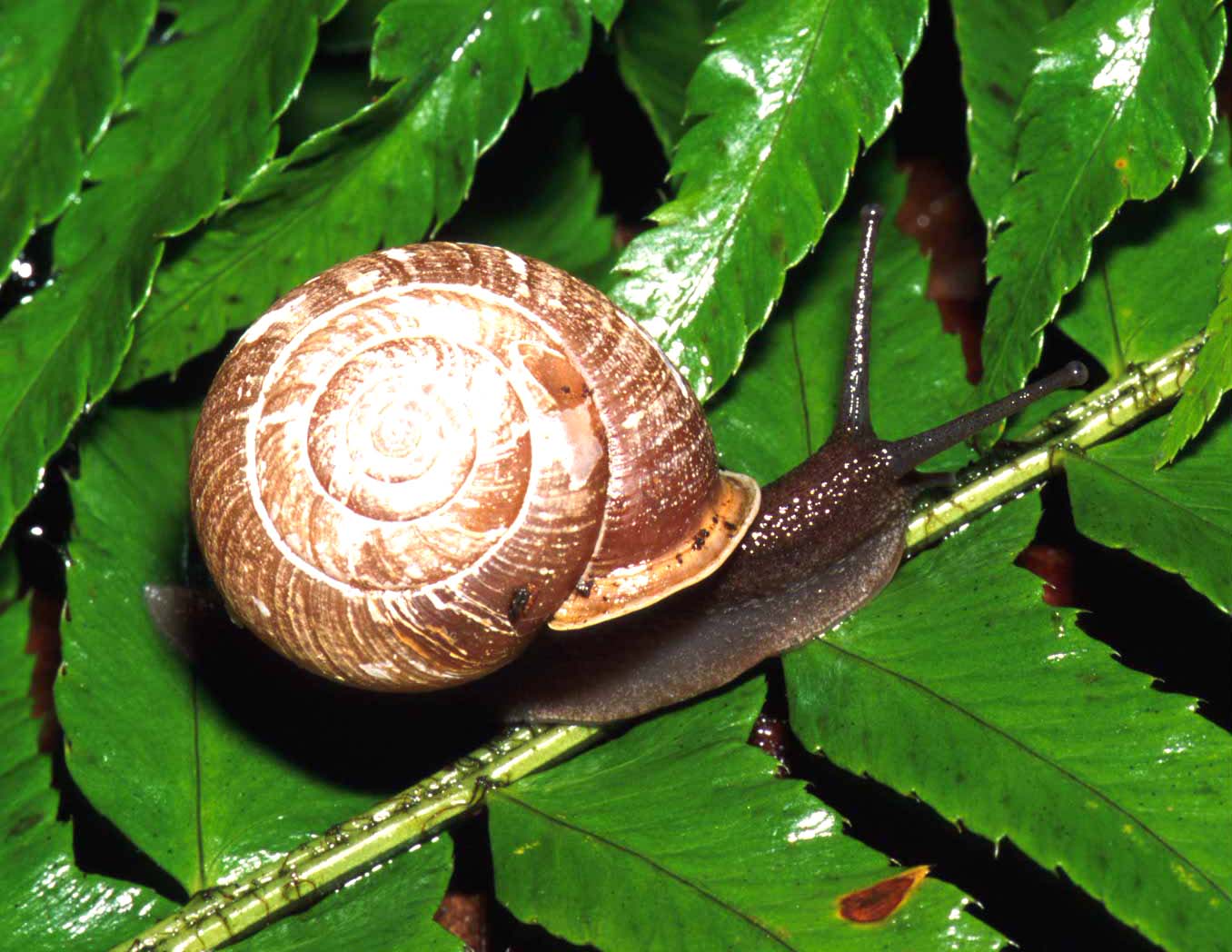

Cryptomastix devia (Gould 1846) Puget Oregonian
Polygyridae, Stylommatophora, Gastropoda, Mollusca, Animalia
Range: C. devia historically ranges from southern Vancouver Island and southwestern British Columbia, Canada, through the Puget Trough and Cascades of Washington to the Oregon side of the Columbia River Gorge. C. devia has not been found in Canada since 1905. We currently know of Washington records in the following counties: King, Kittitas, Pierce, Thurston, Lewis, Cowlitz, Clark, and Skamania. It is locally abundant in the Cowlitz and Nisqually River drainages but apparently rare elsewhere in Washington State. C. devia is known in Oregon from The Dalles to Columbia County. C. devia occurs from near sea level up to 1220 meters on South Cle Elum Ridge, Kittitas County.
Data in the interagency database (Known Sites Data Base v. 2.0), current as of October 1996, contains 36 sites with a description allowing location to within 1.5 miles of the actual location and 32 additional sites described at a more general level.
Identification: Within its range, C. devia can be confused with Allogona townsendiana, Cryptomastix germana, and Monadenia fidelis. Both A. townsendiana and C. devia commonly wear to a white coloration apically, but usually specimens this worn are adults and the parietal denticle of C. devia is obvious. A. townsendi is larger, lacks a parietal denticle, and juveniles lack microscopic hairs. C. germana is much smaller but has a similar parietal denticle. C. germana has longer hairs which are present in adults as well as juveniles. Young M. fidelis may be mistaken for C. devia when they are small, but usually the side-band of M. fidelis can be made out. M. fidelis also has a higher shoulder and a reddish body.
Description: The shell diameter is1.4 to 1.7 times its height, has 5.5 to 6 whorls, and ranges from an 18 to 25mm diameter in adults. The diameter of the umbilicus is about 10% of shell diameter. The umbilicus is partly covered by a white reflected lip. The shell most commonly is dark brown but can range to a yellowish horn; the shell often becomes white apically with wear. Juvenile shells have short microscopic hairs which are lost in more mature specimens. The obtuse spiral channel is within the umbilicus. The lower lip is relatively straight and horizontal and often thickened centrally to form a low basal tooth.
Natural History: Found in moist areas; usually found in leaf thatch under sword ferns in mixed forest.
(Burke) Cryptomastix devia hatch from eggs and live for more than one year.
However, specific details on life span and reproduction for this species were
not found. // Like most Terrestrial gastropods, Cryptomastix are hermaphroditic,
having
both male and female organs. Although not confirmed specifically for C. devia,
self-fertilization has been demonstrated in some species of gastropods, but
cross-fertilization is the norm. Bayne (1973) discussed the complexities of
the
Pulmonate reproductive system, and studied mechanisms by which allosperms
(sperm from another) exert dominance over autosperms (sperm from oneself)
during fertilization. Thus, ". . . self-fertilization is normally avoided,
but remains
a possible alternative to cross-fertilization." The advantage is in normally
avoiding potentially deleterious inbreeding, yet retaining the option to reproduce
if a mate is not available. // Nothing was found in literature sources on the
ecology of Cryptomastix devia,
but Pilsbry (1940) states of the Family Polygyridae, "Their food is chiefly
the
mycelia of fungi." He also says, "The young snails wander abroad more
freely
than adults, and are often found on plants where the adults are under cover."
Although the natural foods of C. devia have not been specifically documented,
one immature specimen was observed to eat lettuce, reluctantly, in captivity
(personal observation). While it is suspected that mycophagy is the primary life
style of this species, it appears that at least the young may be partially
herbivorous on green plants during certain seasons. The species probably has
a
digestive efficiency rate in the high forties for assimilation of food materials,
a
low rate that allows viable spores and fragments of fungal hyphae to be
excreted with the feces. Thus, they represent an important dispersal mechanism
for fungal species throughout the year when this mollusk is active.
Cryptomastix devia is a low to mid-elevation, old-growth forest associate. It
appears to have an affinity to old-growth western hemlock/sword fern plant
associations with bigleaf maple and/or possibly other hardwood componentswell
represented. It is found among deciduous leaf litter, under ferns, on the underside
of hardwood logs, or among rocks within the above or similar plant associations.
It may be found on or under hardwood logs and leaf litter, and rock and talus may also be used if there are cool and moist areas beneath them. This snail is also found on or in the litter under sword ferns growing under hardwood trees and shrubs, especially big-leaf maples. Young individuals may be found under mosses growing on trunks of big-leaf maples
Conservation Status:
Literature Cited:
Sononyms:
Cryptomastix devia Gould 1846
= Triodopsis (Cryptomastix) devia (Gould) in Pilsbry 1940.
= Polygyra devius Hanna and Rixford 1923.
= Polygyra devia Gld., Dall 1905.
= Mesodon devius Binney 1883
= Mesodon devia Gld., Tryon 1867; W.G. Binney 1878.
= Odotropis devia Gld., J.G. Cooper, 1868.
= Helix baskervillei Pfeiffer 1852
= Helix devia Gould 1846
(From Henderson 1929, 1936; and Pilsbry 1940).
Etymology: